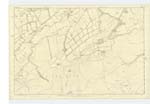OS1/11/27/13
| List of names as written | Various modes of spelling | Authorities for spelling | Situation | Description remarks |
|---|---|---|---|---|
| FORT [Kaimes Hill] | Roman Camp Roman Camp Encampment |
A. Macconnorry Mr. J. Hislop Stat. [Statistical] Acct. [Account] 1845 |
011 | [Situation] About 1⅛ mile E.S.E. [East South East] from Kirknewton [Descriptive Remarks] The remains of an Encampment on the summit of Kaimes Hill. The area of the camp, on the south and east side, is surrounded by a double fosse and rampart, composed of stones and earth; but on the north & west side there is nothing to indicate the boundary but the precipitous declivity of the Hill or rock - The entrance to the camp from the East is quite visible and is represented on the Trace in a dotted line - In the interior of the Camp are several circles composed of earth & stones supposed to have been Towers for defending the Wall or Watch Towers. |
Continued entries/extra info
[Page] 13Parish of Ratho
29 -- Roman Camp
From the shape, situation, & construction of this object it would appear to be a British Hill Fort. Captn [Captain] James R.E. [Royal Engineers] is of this opinion, after having examined it, very particularly, on the ground
"The Kaimes Hill which is in view of this post (The one on south Platt Hill) is the site of another encampment of similar construction and apparently of the same era. Of this encampment the remains are visible. The space occupied by it is about 3 acres in extent and includes the summit with a considerable part of the eastern declivity The area of this camp is surrounded by a double fosse and rampart founded in one place with stones and black earth except on the north side where the rock is so precipitous as to form of itself a sufficient defence. The access to the camp is from the east two large stones still marking what was the place of entrance. On the very summit of the hill there is a cairn of stones, concave in the centre, which is covered with turf greener than the ground around it Towards the north-east in a small valley immediately under the brow of the hill there are to be seen at least 10 circles formed with stones indented or laid in the ground. These which are all within the line of the defences and in the most sheltered place of the encampment are not improbably the remains of huts raised for the purpose of accommodating the sick and wounded during the period of the hill's occupation. At their extremity is still a spring which was no doubt of use to the army generally and might in conjunction with the shelteredness of the position afford a strong motive for such erections in this particular spot. The appearance of the ground in some of these circles, a few of the stones being covered with a rich moss and bearing some stalks of stunted nettles render it possible that some bodies may be here intered. The situation of this encampment by whom soever occupied must have been a place of considerable strength and of great utility commanding as it does an extensive prospect on all sides and consequently not liable to danger of sudden surprise." Stat. [Statistical] Acct. [Account] of Co [County] Edinburgh 1845 Page 91
Transcribers who have contributed to this page.
douglas
Location information for this page.
Linked mapsheets.




